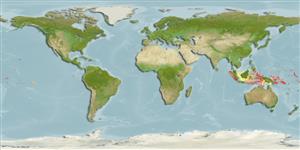>
Gobiiformes (Gobies) >
Gobiidae (Gobies) > Gobiinae
Etymology: Eviota: No etymology given, suggested by Christopher Scharpt: from Latin 'eu' for 'true' and 'iota' for anything very small, in combination 'truly very small' referring to it as being the smallest vertebrate at the time it has benn described by Jenkins (thus, making the suggestion by Scharpt plausible..
More on authors: Jewett & Lachner.
Environment: milieu / climate zone / depth range / distribution range
Ecología
marino asociado a arrecife; rango de profundidad ? - 35 m (Ref. 86942). Tropical; 7°N - 11°S
Distribución
Países | Áreas FAO | Ecosistemas | Ocurrencias, apariciones | Point map | Introducciones | Faunafri
Indo-Pacific: Christmas Island in the eastern Indian Ocean to New Caledonia, Solomon Islands, Fiji, Tonga and French Polynesia (Austral Islands); north to Japan (Okinawa and Ryukyu Islands); south to Indonesia (Sulawesi, Lesser Sundas, Banda, West Papua); including Micronesia (Palau, FSM [Pohnpei], and Kiribati).
Tamaño / Peso / Age
Maturity: Lm ? range ? - ? cm
Max length : 1.5 cm SL macho / no sexado; (Ref. 1602); 1.2 cm SL (female)
Short description
Claves de identificación | Morfología | Morfometría
Espinas dorsales (total) : 7; Radios blandos dorsales (total) : 7 - 9; Espinas anales: 1; Radios blandos anales: 8 - 9. Characterized by semi-transparent body with 6-7 broad brown bars or blotches on side; head with white marks dorsally; longitudinal scale series 23-25; ctenoid scales, absent on head, nape, chest and pectoral fin base; separated pelvic fins, thin membrane joining bases; 7-11 branches of fourth pelvic ray; depth of body 4.5-5.0 in SL (Ref. 90102).
Occurs from less than 5 to between 8 and 24 m. Solitary, rests on bottom. Inhabits exposed coastal reefs and outer slopes (Ref 90102).
Life cycle and mating behavior
Maturities | Reproducción | Spawnings | Egg(s) | Fecundities | Larva
Greenfield, D.W. and R. Winterbottom, 2016. A key to the dwarfgoby species (Teleostei: Gobiidae: Eviota) described between 1871 and 2016. J. Ocean Sci. Found. 24:35-90. (Ref. 113727)
IUCN Red List Status (Ref. 130435)
Threat to humans
Harmless
Human uses
Herramientas
Special reports
Download XML
Fuentes de Internet
Estimates based on models
Preferred temperature (Ref.
123201): 28.2 - 29.4, mean 28.9 °C (based on 744 cells).
Phylogenetic diversity index (Ref.
82804): PD
50 = 0.5000 [Uniqueness, from 0.5 = low to 2.0 = high].
Bayesian length-weight: a=0.00708 (0.00333 - 0.01504), b=3.09 (2.92 - 3.26), in cm total length, based on LWR estimates for this (Sub)family-body shape (Ref.
93245).
Nivel trófico (Ref.
69278): 3.0 ±0.3 se; based on size and trophs of closest relatives
Resiliencia (Ref.
120179): Alto, población duplicada en un tiempo mínimo inferior a 15 meses (Preliminary K or Fecundity.).
Fishing Vulnerability (Ref.
59153): Low vulnerability (10 of 100).
Nutrients (Ref.
124155): Calcium = 656 [236, 3,125] mg/100g; Iron = 2.5 [0.8, 6.7] mg/100g; Protein = 17.3 [15.0, 19.6] %; Omega3 = 0.107 [0.022, 0.514] g/100g; Selenium = 54.6 [9.2, 253.1] μg/100g; VitaminA = 80.6 [9.0, 653.8] μg/100g; Zinc = 7.56 [3.24, 14.78] mg/100g (wet weight);
